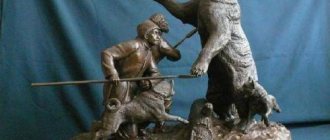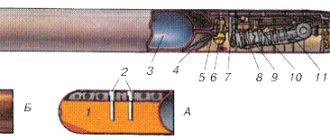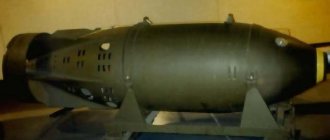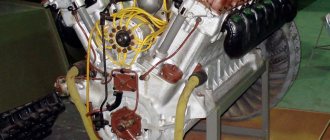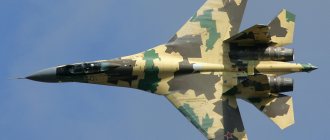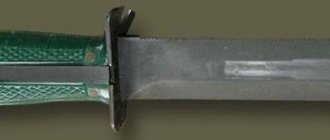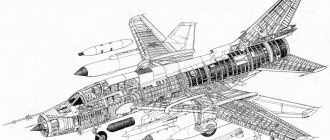Air guns come in a wide variety of designs and calibers. Accordingly, their ammunition also comes in many forms, each of which has its own special purpose. As for the caliber, based on this indicator, all pneumatics are divided into three large groups:
- Small caliber – 4.5 – 35 mm.
- Average - 7.62 - 9 mm.
- Large – 11.43 – 5 mm.
In Russia, the 4.5 mm caliber is mainly popular. The shape of ammunition can be very different:
- Dart.
- Expansive bullets.
- Ball.
- Dum-dum bullets.
- "Diablo"
- Bullets with blunt, conical, ogive and hemispherical nose.
- Flash-noise and explosive ammunition.
Smooth-bore weapons use iron balls and darts, while rifled weapons use bullets made of plastic, aluminum and lead. And now more about each of the varieties.
Light bullets
Most models of air guns are characterized by limited power, which makes it possible to create lightweight bullets and helps reduce their friction in the barrel. Loading low-power rifles requires two types of bullets:
- “Cap”, which has a very low weight (0.545 grams).
- "Shuttlecock." The design of this bullet consists of a head and a shank shaped like a skirt. This gives the ammunition stability during flight. The rifling in the barrel provides the bullet with rotation, which also has a positive effect on the accuracy of hits. “Volanchik” is considered a more progressive option. The efficiency of an air rifle with such a bullet increases as its friction inside the barrel decreases. A bullet with a shuttlecock shape is ineffective when hunting large game.
In terms of their aerodynamic properties, the “cap” and “shuttlecock” are not ideal options. The 4.5 pneumatic bullet represents a compromise between its lethality and accuracy depending on the degree of expansion.
Other types of pneumatic balls and bullets
In addition to all of the above, lead bullets are very popular among airgun shooters. Their main advantage is stabilization by rotation after passing along the rifling of the barrel. This allows for much greater accuracy than shooting pellets or, especially, core cartridges. Also, from us you have the opportunity to purchase light-noise lead pneumatic bullets, hn, order pyrotechnic, light-sound, incendiary bullets for pneumatics and many other equally effective options that will certainly help you brighten up your leisure time.
Expansive bullets
With the improvement of models on the shelves, in addition to standard air rifles, more powerful models appeared. This entailed the creation of new bullets, the weight of which should correspond to the power of the weapon. Bullets weighing 0.67 grams were used in standard wind models. High-power models require the use of heavier ammunition. The heaviest bullets for 4.5 mm air rifles are the result of the appearance of such powerful rifles on the arms markets as the Hatsan and Evanix. Compared to light 0.67-gram ones, expansive ones have worse ballistic performance and accuracy.
Review of the best explosive bullets
| Place | Name | Rating | price, rub. |
| 1 | Bullets Blik 0.25 g (50 pcs.) | 7.9/10 | 195 |
| 2 | Quintor Phantom bullets 0.25 g (50 pcs.) | 8.4/10 | 210 |
| 3 | Light and sound pistons for MP-654 (20 pcs.) | 9.4/10 | 295 |
1st place – Puli Blik
These are explosive bullets, when contact with the target is accompanied by a loud sound and a powerful flash. You can choose it for preliminary zeroing of pneumatic weapons, to practice situational shooting. There are 50 pcs in a pack, approximate weight – 0.25 g.
They are designed with a lead core, a plastic container and a detonating substance. Hitting the target is accompanied by a flash up to 5 cm in size. It can be used to provide a light and sound signal and shoot birds in the garden.
2nd place – Puli Quintor Phantom
These pyrotechnic bullets are used to audibly and visually determine where they hit the target. Can be used for special effects during filming or for entertainment.
They consist of an explosive and a plastic container in which a lead core is installed. Hitting the target is accompanied by a loud sound and long sparks like sparklers. Can be used for shooting, signaling, scaring away crows.
Characteristics, description
- Weight is 0.67 grams.
- Speed - 270 m/s.
- Power - 25 J.
The energy and expansion of the 4.5 Edgun air rifle bullet does not make it suitable for small game hunting. A lead product can penetrate right through and take with it the energy that ensures defeat. The result is not a trophy, but a wounded animal. The Czech 4.5 mm Edgun pneumatic bullet has high accuracy, as evidenced by testing using plasticine bars. After the shot was fired and the bar was cut longitudinally, this lead product left an even channel 11 cm long. At the same time, the bullet did not change its direction and was not deformed.
Crosman Lead Products
4.5 Crosman pneumatic bullets are considered one of the best 4.5 mm bullets. They have two drawbacks that have negatively affected their popularity. The first is that a large number of fakes have appeared on the arms markets. The second is that very hard lead is used in production, as a result of which friction occurs in the barrel, and bullets for 4.5 Crosman pneumatics lose their power.
Products from Ilandler & Natermann
In hunting farms, problems caused by pest birds often arise. Crows are the biggest nuisance. In the fight against them, the company Ilandler & Natermann invented special 4.5 mm caliber bullets, which are called Crow Magnum (translated from English as crow). Selecting 4.5 caliber pneumatic bullets for crow hunting. Experts recommend choosing the products of this company. Crows differ from other birds in their high endurance, and it is not advisable to use conventional hollow-point bullets against them. They will simply pierce the pest right through, allowing it to fly another couple of tens of meters until the end comes.
In addition to being highly expansive, 4.5 Magnum pneumatic bullets are capable of causing a water hammer upon impact, causing shock in game. Crow Magnum lead products have an inherent stopping effect. In their shape they are similar to 4.5 Barracuda pneumatic bullets.
The difference is that the Ilandler & Natermann lead product has a larger cylindrical recess in the head than the Barracuda. And, therefore, the diameter of the wound is larger.
Classification of bullets by shape
The classic bullet shape looks like a “coil” or “shuttlecock” and is called “Diablo”. Cartridges of the so-called “ogive” shape, which are known to many from military weapons, are very rarely used.
This is due to the relatively low power of pneumatics with a caliber of 4.5 mm. The insufficient contact area between the bullet and the barrel channel in the area of the “skirt” and the head belt significantly reduces the speed during friction, but does not allow gas breakthrough. For very powerful preloaded shotguns (PCP), starting from the 7.62 mm caliber, on the contrary, only “ogive” bullets are used.
Shuttlecocks have different types and subtypes, which differ in weight, caliber, workmanship, ballistic performance and technical features. The choice of bullets will depend on the application.
Thus, flat-head bullets, which are often marked "Match", are typically used for precision practice shooting with match airguns at a distance of 10 m. These bullets leave clear, round holes on targets to determine the result of shooting.
For hunting and recreational use at distances greater than 50 m, “flat-head” bullets are not suitable. But with low penetrating ability, they have high stopping performance.
For “plinking” and hunting, the most commonly used bullets are called “Domed” (“dome”), they have a hemispherical head and are universal for any gun and shooting at any distance.
Due to their high penetrating ability, conical bullets (“Point”, translated from English as “point”) are used for hunting with Magnum series shotguns. They have low ballistic characteristics. The same applies to “Hollow Point” bullets (translated as “point with a cavity”). But thanks to their special design, they transmit maximum energy when hitting a target at optimal distances and have a high stopping effect. When a bullet hits an animal, it opens like a flower, tearing the surface.
Behind the menacing name “Terminator” is an attempt to make some kind of analogue of bullets with a core. Thus, they combine the principles of high stopping power and penetration (penetrating power). Unless long range shooting is required, these cartridges are very effective, most often used for airguns with power greater than 16 Joules.
Characteristics of the Crow Magnum bullet
The bullet weighs 0.58 grams. The product is characterized by low trajectory flatness and accuracy, which is confirmed after firing ten shots. From a distance of 50 meters, the accuracy is 5-6 cm.
Testing using plasticine bars indicates that the 4.5 Magnum pneumatic bullet quickly loses its initial velocity. A plasticine block cut lengthwise after a shot has a channel, the length of which is 5-6 cm. The location of lead particles in it suggests a tendency for these bullets to deform in the block. But at the same time, the diameter of the channel is twice as wide as the diameter left by other bullets for 4.5 pneumatics.
Reviews from owners of air rifles using Crow Magnum indicate the high effectiveness of these bullets for shooting game at a distance not exceeding forty meters.
How to choose the right bullets
A few recommendations from experts when selecting and using pneumatic bullets:
- all bullets in the package should be shiny and free of oil residues or deposits;
- When selecting bullets for pneumatics, it is best to give preference only to trusted manufacturing companies. This will prevent damage to the barrel channel and avoid damage to the rifling;
- the skirt of the bullets should not be deformed, that is, not wrinkled or cut off;
- there should be no visible notches or seams on stamped cartridges;
- If you are in doubt about which pneumatic bullets to buy, try several types with different parameters or products from different manufacturers. After shooting and determining the results, you can understand which ones are better;
- make sure that all the bullets in one package are exactly the same;
- lightweight cartridges are best suited for short-range shooting;
- Expansive and highly deformable bullets are used for hunting;
- for entertainment, you can choose medium or heavy cartridges if the initial speed of the weapon is more than 120 m/s.
Features of storing pneumatic bullets:
- bullets should be stored in a dry and clean place;
- You need to carefully inspect the bullets before use, they must be clean and close to ideal shape. The pack of cartridges should not contain metal shavings or production waste;
- If possible, buy a safe - it will protect you from troubles;
- bullets should not be accessible to children;
- Cartridge packages should not be dropped due to the softness of the material. During an impact they are deformed, this affects the accuracy of fire;
- lead bullets are quite soft, there is no need to store them near heating devices, they are deformed and lose their shape;
- look at the production date of the bullets, if it is not indicated on the pack, ask the seller how long they have been sold.
Bullets that have lain for a long time in warehouses or on a counter warm from lamps are always worse than products made recently.
Every year, new varieties of air rifle cartridges with different shapes and different parameters appear in gun stores. There is no general assessment when selecting bullets.
Lead products of the Tula enterprise Taiga LLC
At the Tula plant, using German equipment and technology from Collin, bullets for pneumatic 4.5 “Shmel” are produced.
- The head of the bullets has a semicircular conical shape. This enhances their penetrating qualities at long distances.
- Lead products are characterized by high stability in flight.
- The initial speed exceeds 190 m/s. Recommended for air rifles with a speed of at least 190 m/s.
- Weight - 0.68 g.
- Bullet type: pneumatic pointed.
- Caliber - 4.5 mm.
- The pack contains 400 pieces.
These bullets are intended for 4.5 pneumatics for hunting game birds. Tula lead products are effective in the fight against crows and small rodent pests.
In architecture
Arches and windows of ogival form, traditional in Gothic architecture, are called “lancet” in Russian literature.
Ogival arches, for example from wooden structures, also called “high arches” K: Wikipedia: Articles without sources (type: unspecified)[ source unspecified 3178 days
] are used in the construction of warehouses for storing bulk materials K: Wikipedia: Articles without sources (type: not specified) [
source not specified 3178 days
].
Which bullets are better?
Every year, new versions of bullets with different designs and shapes appear on gun counters. There is no single assessment when choosing lead ammunition for air rifles.
- During outdoor activities, it is recommended to use ogive-shaped bullets. They are applicable in very powerful blowguns with an initial speed of at least 300 m/s. This is because the structure of ammunition is very similar to the design of projectiles used in firearms. Ogival-shaped bullets are not recommended for use in rifled weapons, as this will lead to damage to the barrel.
- Flash-noise bullets are equipped with explosive charges in their head. Upon contact with the target, detonation occurs, which does not entail any serious consequences. Damage upon impact is minimal. The hit is accompanied by a visual and audio signal. This type of bullet is used for entertainment purposes.
- Lead bullets with a conical head. Used for hunting large animals. The product has high penetrating power and poor shooting accuracy.
- Expansive lead bullets are intended for hunting. The design of the head of these ammunition has a recess that creates a void in the bullet. After hitting the target, the warhead breaks due to the void, and the bullet is deformed, which increases the diameter of the lesion. An expansive bullet does not leave wounded animals in the hunt.
Bubble Bullet
Recently, the Norwegian company DSG Technology introduced a new type of ammunition for small arms that can be effectively fired both on land and under water. The new bullets take advantage of one of the physics that sailors are most familiar with. We are talking about cavitation - the process of formation and rapid collapse of bubbles filled with steam in a liquid. Initially, the phenomenon of cavitation was considered harmful, capable only of harming ships. But later they found useful applications for it. We decided to remember how the military uses cavitation to their advantage.
In the second half of the 19th century, steamships with propellers capable of reaching speeds of several tens of knots began to appear. These cars could quickly transport passengers and generally compared favorably with slow sailing ships. However, the sailors soon encountered an unpleasant effect: the surface of the propellers, after some time of operation, became rough and destroyed. Propellers were then made of steel and themselves quickly corroded in water, so their destruction was initially attributed to the adverse effects of sea water. But at the end of the 19th century, scientists, including John William Strett, Lord Raleigh, described the phenomenon of cavitation.
Cavitation is a physical phenomenon in which tiny bubbles filled with steam appear in a liquid behind a fast-moving object. For example, when a propeller rotates, such bubbles appear behind the blades and on their trailing edge. Once these bubbles appear, they collapse almost instantly and form a shock wave. From each bubble individually, it is completely insignificant, however, over long-term operation, these shock microwaves, multiplied by the number of bubbles, lead to the destruction of the screw structure. Rough propellers that have lost part of the blade significantly lose their effectiveness.
Modern propellers are made of a special alloy - kunial. It is a copper-based alloy with the addition of nickel and aluminum. Hence the name - cunial (CuNiAl, Cuprum-Niccolum-Aluminum
). The alloy has the same strength as steel, but is not subject to corrosion; Kunial propellers can remain in the water for decades without any harm. However, even these modern propellers are susceptible to destruction due to cavitation. But experts have learned to extend their service life by creating a hydroacoustic system. It detects the onset of cavitation so that the crew can reduce the propeller speed to prevent bubble formation.
In the 1970s, useful applications were found for cavitation. The Research Institute of the USSR Navy has developed a high-speed underwater missile-torpedo “Shkval”. Unlike conventional torpedoes used then and in service today, Shkval can reach a colossal speed of up to 270 knots (about 500 kilometers per hour). By comparison, conventional torpedoes can reach speeds of 30 to 70 knots, depending on the type. When developing the Shkval torpedo missile, researchers, thanks to cavitation, were able to get rid of water resistance, which prevents ships, torpedoes and submarines from developing high speeds.
Any even streamlined object under water has high drag. This is due to the density and viscosity of water - greater than that of air. In addition, when moving under water, the surfaces of the object are wetted and a thin laminar layer with a large velocity gradient appears on them - from zero at the very surface of the object to the flow velocity at the outer boundary. This laminar layer creates additional resistance. An attempt to overcome it, for example, with engine power, will lead to increased loads on the propellers and rapid wear of the hull of the underwater object due to deformation.
During experiments, Soviet engineers found that cavitation can significantly reduce the drag of an underwater object. The Shkval torpedo missile received a rocket engine, the fuel in which begins to oxidize upon contact with sea water. This engine can accelerate a torpedo missile to high speed, at which a cavitation bubble begins to form in the bow of the Shkval, completely enveloping the ammunition. The formation of a cavitation bubble is facilitated by a special device in the bow of a torpedo rocket - a cavitator.
The cavitator on the Shkval is an inclined flat washer, in the center of which there is a hole for water intake. Through this hole, water enters the engine compartment, where fuel oxidation occurs. A cavitation bubble is formed at the edges of the cavitator washer. The torpedo rocket literally flies in this bubble. The upgraded version of Shkval can hit enemy ships at a range of up to 13 kilometers. Compared to the range of conventional torpedoes (30–140 kilometers), this is not much, and this is the main drawback of the ammunition. The fact is that during flight, a torpedo missile makes a loud noise, unmasking the position of the submarine that launched it. The Shkval covers 13 kilometers very quickly, but during this time the submarine will not have time to escape return fire.
A torpedo missile flying in a cavitation bubble cannot maneuver. This is quite understandable: in a cavitation cavity, the ammunition cannot interact with water to change direction. In addition, a sharp change in the trajectory of movement will lead to partial collapse of the cavitation cavity, due to which part of the torpedo missile will end up in the water and be destroyed at high speed. Initially, Shkval was equipped with a nuclear warhead with a capacity of 150 kilotons, which was later replaced by a conventional high-explosive warhead with an explosive mass of 210 kilograms. Today, in addition to Russia, Germany and Iran are armed with cavitating torpedoes.
Cavitator of the Shkval torpedo missile
One half 3544 / Wikimedia Commons
Share
In 2014, the Harbin Institute of Technology presented a concept for a submarine capable of traveling underwater at near or even supersonic speeds. The developers announced that such a submarine would be able to sail from Shanghai to San Francisco (about ten thousand kilometers) in about one hour and 40 minutes. The submarine will move inside the cavitation cavity. The new submarine will have a cavitator in the bow, which will start operating at speeds of more than 40 knots. Then the submarine will be able to quickly pick up cruising speed. Rocket engines will be responsible for the movement of the submarine in the cavitation cavity.
The speed of sound in water is about 5.5 thousand kilometers per hour at a temperature of 24 degrees and a salinity of 35 ppm. Presenting their concept, the developers noted that before creating a new submarine, several problems need to be solved. One of them is the instability of the cavitation bubble within which the submarine must fly. In addition, it is necessary to find a reliable way to control a ship moving underwater at supersonic speed. As one of the options, the possibility of making rudders that would extend beyond the cavitation cavity is being considered.
Meanwhile, in the early 2000s, the Central Design and Research Bureau of Sports and Hunting Weapons of the Tula Instrument Design Bureau decided to use the phenomenon of cavitation when creating a new machine gun for combat swimmers. We are talking about an ADS (double-medium special assault rifle) - an assault rifle capable of firing equally effectively both in the air and under water. The weapon is made according to the bullpup design (the trigger mechanism is located in the butt) and has an integrated grenade launcher. The weight of the weapon with a length of 685 millimeters is 4.6 kilograms.
This machine gun uses special 5.45 mm PSP cartridges for firing underwater. They are equipped with a steel bullet in the form of a needle 53 millimeters long. The bullet weight is 16 grams. The projectile is recessed into a cartridge case with a powder charge for most of its length, so that the overall length of the cartridge corresponds to conventional 5.45 mm caliber automatic ammunition. The PSP cartridge bullet has a flat area at the tip. When moving underwater, this platform creates a cavitation cavity around the projectile. Thanks to this feature, the effective firing range of the ADS underwater at a depth of five meters is 25 meters.
In addition to special cartridges, the machine gun is capable of firing conventional ammunition. The ADS can be equipped with a muffler. The rate of fire of the ADF on land is 800 rounds per minute, and the target range is 500 meters. The weapon is equipped with a detachable box magazine with a capacity of 30 rounds. The machine has a switch for operating modes of the water/air gas exhaust mechanism. It changes the operation of the reloading mechanism, adapting it to work in air or water. Without separate modes, the recharging mechanism in water could jam.
Conventional modern weapons are also capable of firing underwater, but are of little use for these purposes. Firstly, the inertial resistance of the liquid and the greater density of water than air does not allow automatic weapons to quickly reload weapons, and sometimes even makes it impossible. Secondly, the materials of land-based assault rifles and pistols are not initially designed to work in an aquatic environment and are not resistant to prolonged exposure - they quickly lose lubrication, rust and fail due to hydraulic shocks. At the same time, ordinary bullets, which are highly accurate on land, become completely useless in water.
The fact is that the aerodynamic shape of an ordinary bullet makes the trajectory of its flight in water difficult to predict. For example, at the boundary of warm and cold water layers, a bullet can ricochet, deviating from the longitudinal axis of the shot. In addition, due to its shape, a small arms projectile under water quickly loses its energy, and therefore its lethality. As a result, hitting a target with the same Kalashnikov assault rifle in water becomes almost impossible even at a very short distance. Finally, ordinary lead bullets with a tombac jacket (a brass alloy based on copper and nickel) quickly deform under water and can even be destroyed.
The problem of disintegrating bullets was solved by the Norwegian company DSG Technology. She developed a new type of ammunition, CAV-X. They do not have a classic ogive shape, like ordinary bullets, but a conical shape. The tip of the bullet is flattened and when it hits water it begins to act as a cavitator, due to which a cavitation cavity is formed around the projectile. As a result, the bullet practically does not come into contact with water and retains kinetic energy longer. CAV-X cavitating bullets are not much longer than conventional bullets of the same caliber, unlike Russian bullets in the PSP cartridge.
Cavitating bullets are made of tungsten and pressed into a brass case. Today they are produced in calibers 5.56, 7.62 and 12.7 millimeters. According to DSG Technology, under water, cavitating bullets of these calibers retain their lethal effect at ranges of 14, 22 and 60 meters, respectively. At the same time, ammunition of other calibers up to artillery 155 millimeters can also be cavitated. True, the feasibility of creating shells for underwater shooting is very doubtful. It is not yet known what kind of weapon CAV-X cavitating bullets are planned to be used in. Conventional small arms without special modifications are not suitable for shooting underwater.
However, cavitating bullets can be useful when firing at underwater targets from land. If you shoot, say, at a combat swimmer underwater from the shore with a conventional pistol or machine gun, then most likely he will swim away unharmed. The fact is that the bullets will either slow down sharply when they hit the water or ricochet away from it; this depends on the angle of the barrel axis to the surface of the water at which the shooting is carried out. Cavitating bullets will be able, practically without deflection, to pass the surface of the water and hit an underwater target. But the military does not face the need to shoot at an underwater enemy from land so often that they begin mass purchases of cartridges with CAV-X bullets.
Although military engineers were able to find useful uses for cavitation, by and large their inventions were not particularly popular. Shkval missile-torpedoes have never been used in combat, and today they are not used at all by the Russian fleet - these ammunition turned out to be too noisy and short-range. Cartridges for underwater shooting are in demand only by combat swimmers and saboteurs and are used quite rarely. The ability of Chinese specialists to design a cavitating submarine is hard to believe. So, perhaps, cavitation is still a physical phenomenon that it is better to try to avoid.
US Navy
Vasily Sychev
What should you consider when buying bullets for 4.5 pneumatics?
- Hunting requires the selection of lead products that provide a compromise between expansiveness and accuracy. For an air rifle using 4.5mm pellets, long range is considered to be distances greater than forty meters. In this case, it is recommended to use lead products that have a solid dome head. But there are cases when hunting takes place at distances not exceeding forty meters. At this distance, bullets with a characteristic deformation of the head section will be ideal. Such bullets, according to hunters, have a weak destructive effect, but are highly accurate, which is important when shooting at short distances. The main thing is to hit the game in its vital organs.
- If a lead bullet with an expansive action is not available, you can use any other bullet, loading it into an air rifle with the tang first. At the same time, acting as expansive, such ammunition greatly loses accuracy. Therefore, loading is effective only in cases where shooting is carried out at short distances.
- When hunting large game, a lead bullet with a hemispherical head is ideal. Lead and antimony are used in its production, which improves its strength.
- When purchasing 4.5mm bullets, you need to remember that this lead ammunition comes in a variety of shapes. Their weight can reach 1.05 grams. Not every air rifle can shoot such products. The heaviest bullets, having a caliber of 4.5 mm, are intended only for weapons that can impart acceleration of up to 300 m/s.
Taking into account all the nuances and subtleties when selecting lead ammunition for air rifles, you can select the necessary bullet option for each hunt, which will have a positive impact on the quality of shooting.
The invention relates to a bullet having a front, when viewed in the direction of the shot, head part, which along the ogive part passes into a rear region shaped like a cylinder.
22 1r (5.6 mm) caliber cartridges currently exclusively have a bullet with an ogive part, the surface of which is made smooth. Attempts have been made to improve the flight characteristics of the bullet using the shape of the ogival part.
The objective of the invention is to improve the bullet according to the restrictive part of claim 1, which has low air resistance and optimal accuracy.
According to the invention, this problem is solved by creating a certain structure on the surface of the ogive. Unexpectedly, it turned out that just by slightly shaping the surface structure, both air resistance and bullet accuracy can be improved.
In a preferred embodiment, the surface has recesses. They can be applied easily.
In a preferred embodiment, the recesses are teardrop-shaped. Thanks to the special teardrop-shaped recesses on the ogival part, the air resistance changes positively. This results in a flatter and more uniform flight path and thus higher accuracy.
Preferably, the recesses are located on circles surrounding the ogive and located perpendicular to the longitudinal axis of the bullet, with the recesses on the circles preferably adjacent to each other. The recesses are located so that the resulting turbulences are summed and subtracted, resulting in an optimal coefficient of resistance to flow movement Cw.
This can be further improved if the recesses on one circle are positioned offset from the recesses on the adjacent circle, so that one recess is located on the same circle between the recesses of the adjacent circle.
It is most favorable if the recesses on one circle are offset relative to the recesses on the adjacent circle by half the diameter of the recess. This form of implementation is shown in the figures, which will be discussed below.
Preferably, four circles are located on the ogival part.
In a preferred embodiment, under the recesses away from the bullet head on the cylindrical region there are running grooves running parallel to the circles. The grooves located in the cylindrical region are responsible for directing the air flow, formed by the teardrop-shaped depressions, optimally around the bullet. This makes the bullet noticeably less sensitive to atmospheric conditions such as wind and rain/snow.
In a preferred embodiment, the surface of the bullet head is made flat, and under the recesses in the direction from the bullet head up to the grooves there is a “calming” zone, the surface of which is flat. In these areas, vortices occur. Thanks to the smooth surfaces, the air flow “calms down”.
It is preferable to use the claimed bullet for .221r (5.6 mm) caliber cartridges, in particular for side-fire cartridges.
The invention is explained below in more detail with reference to the drawings.
In fig. Figure 1 shows the claimed bullet with its head 9, which along the ogive part 1 passes into the cylindrical region 7. On the surface of the ogive part 1, recesses 2 are located as structural formations.
These recesses 2 are teardrop-shaped, so that the larger diameter 5 is in the lower half of the teardrop shape, i.e. away from the bullet head 9. Starting from the top of the teardrop, which points in the direction of the bullet head 9, the diameter of the teardrop shape increases smoothly to the largest diameter 5, and then decreases smoothly again.
These recesses 2 are located on the circles 4a, 4b, 4c 4d (see Fig. 2a and 2b), which surround the ogive part 1 and are located perpendicular to the longitudinal axis 3 of the bullet. On these circles 4a, 4b, 4c, 4d, the recesses 2 are located next to each other in the form shown here. The recesses 2 on the circle 4b are offset relative to the recesses 2 on the adjacent circle 4a or 4c, so that the recess 2 is located on the circle 4a, 4b, 4c, 4d between two recesses 2 on the adjacent circle 4ab, 4b, 4c, 4d. Preferably, the recesses 2 on the circle 4a, 4b, 4c, 4d are offset relative to the recesses 2 on the adjacent circle 4a, 4b, 4c, 4d by half the diameter 5 (see Fig. 2b) of the recess 2. By diameter 5 of the recess 2 we mean the width of the recess 2 by surfaces.
In fig. 2a schematically shows the circles 4a, 4b, 4c, 4d on the ogival part 1 of the bullet, on which the indentations 2 are located. It is clearly seen that the indentations 2 on the circle 4a, 4b, 4c, 4d are displaced in the radial direction relative to the indentations 2 on the adjacent circle 4a, 4b, 4c, 4d. Recesses 2 fig. 2 are teardrop-shaped.
Under the recesses 2 away from the bullet head 9 on the cylindrical area 7 there are grooves 8 running parallel to the circles 4a, 4b, 4c, 4d.
Thanks to the special drop-shaped shape of the recesses 2 on the ogival part 1 of the bullet, the resistance of the bullet to air changes positively. This contributes to a flatter and more uniform flight path and thus higher hit accuracy. The recesses 2 are located so that the resulting vortices are summed and subtracted, thereby achieving the optimal Cw value.
The grooves 8 located in the cylindrical region 7 are designed in such a way that they direct the air flow generated by the teardrop-shaped recesses 2 in an optimal manner around the bullet. Thus, the bullet becomes significantly less sensitive to atmospheric phenomena such as wind and rain/snow.
The area in which the vortices are observed is defined so that the bullet head 9 is flat, i.e. does not have any recesses, and between the recesses 2 and the grooves 8 there is a “calming” zone 10, the surface of which is smooth and helps to “calm” the air flow.
